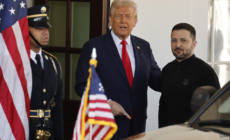-
Lawrence Summers: This Law Made Me Ashamed of My Country - 9 mins ago
-
JD Vance Heckled, Booed at California Dinner - 26 mins ago
-
Haiti’s Landmark Oloffson Hotel is Destroyed in an Apparent Arson Fire - 53 mins ago
-
Kamala Harris’ Comeback Hopes Take a Major Blow - about 1 hour ago
-
US Immigration Backlog Hits All-Time High - 2 hours ago
-
South Korea Holds Its Chin Up as Trump Wields Tariff Threat - 2 hours ago
-
Couple Order ‘Non-Alcoholic’ Wine at Restaurant in Europe—Doesn’t Go Well - 2 hours ago
-
5 Israeli Soldiers Killed in Gaza, Military Says - 2 hours ago
-
Donald Trump Sending More Weapons to Ukraine: What We Know - 3 hours ago
-
What to Know About P.O.W.s in Myanmar’s Brutal Civil War - 3 hours ago
Trump Signs Sweeping Tariffs on Canada, Mexico, and China Trade
President Donald Trump has signed an order seeking to impose significant tariffs on America’s largest trading partners through the International Emergency Economic Powers Act (IEEPA).
Trump had repeatedly promised to impose tariffs on the United States’ closest trading partners, citing concerns over fentanyl flow and trade deficits.
The order implements a 25 percent tariff on imports from Mexico and Canada (with a 10 percent rate for Canadian oil) and a 10 percent tariff on Chinese imports. The White House indicates rates could increase if countries retaliate.
Why It Matters
Tariffs are taxes on imported goods, typically paid by the importing businesses, which can then pass costs onto consumers through higher prices.
In this case, the importing business would be any American company that purchases goods from foreign suppliers and brings them into the country for resale, manufacturing, or distribution.
Trump’s new tariffs could significantly raise costs for products ranging from automobiles to fresh produce, which flow across North American borders daily.
The potential economic consequences extend beyond price hikes. Canadian Prime Minister Justin Trudeau has warned of difficult times ahead, while Mexico President Claudia Sheinbaum has emphasized ongoing dialogue but indicated Mexico has “Plan A, Plan B, Plan C for what the United States government decides.”

What Is A Tariff?
When countries import goods, their governments often impose taxes called tariffs on these products.
These fees are typically paid by businesses bringing goods into the country, though the costs often reach consumers through higher prices. Tariffs serve multiple purposes: they can protect domestic industries, generate government revenue, or pressure other nations to change policies.
In today’s global economy, most nations have moved away from heavy tariff use, preferring free trade agreements that reduce these barriers. However, governments may still implement tariffs for specific policy goals or in response to international disputes.
This is a developing story and will be updated as more information becomes available.
Source link



















